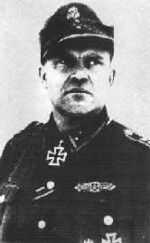Žanis Ansons
| Žanis Ansons | |
|---|---|
 | |
| Born |
4 December 1911 Kandava, Latvia |
| Died |
24 November 1968 (aged 56) Latvian SSR |
| Allegiance |
|
| Service/branch |
|
| Years of service | 1942–1945 |
| Rank | Hauptscharführer |
| Unit |
|
| Battles/wars | World War II |
| Awards |
|
Žanis Ansons (4 December 1911 – 24 November 1968) was a Latvian member of Waffen-SS, Germany's World War II fighting unit of the Schutzstaffel (Protective Squadron). He rose to the rank of Hauptscharführer and was a recipient of the Knight's Cross of the Iron Cross, an award given in recognition of extreme battlefield bravery or successful military leadership. At the conclusion of the war, he was taken prisoner by the Red Army.
Biographical details
A native of Kandava, a small town in Latvian region of Courland, Žanis Ansons was born into a farming family.[1] He graduated local primary school in Kandava. After compulsory military service in Latvian army, he worked in his father's farm.
In the aftermath of Germany's June 1941 invasion of the Soviet Union in Operation Barbarossa, Latvia fell under German occupation, and Ansons volunteered to join the Latvian Brigade, a fighting unit incorporated into German military command. He was posted to 1st Company, 24th Talsi Police Battalion, where he remained until March 1943, when he was transferred to 3rd Company, 2nd. Latvian Regiment in the newly formed Latvian Brigade. In October he was promoted to the rank of Oberscharführer and, in April 1944, to Hauptscharführer in the 6th Company, Waffen Grenadier Regiment of the SS 44, 19th Waffen Grenadier Division of the SS (2nd Latvian), and fought during the Battle of Leningrad. Ansons also participated in the fighting at the Courland pocket where, according to the commendation, he exhibited bravery deserving of the Knight's Cross awarded to him in December 1944. He was the first Latvian NCO who was awarded with it.
Over the night of 27 December the Red Army had broken through the front line and penetrated about two kilometres into the rear. Ansons was sent on a reconnaissance of point 73, to determine enemy strength and positions. The eight men under his command, armed with hand grenades and machine guns, assaulted point 73 and drove off the soviet reserve and artillery observers and pushed the soviets back to their starting positions.[1]
After capitulation of German forces in the Courland pocket, he didn't surrender and he went into hiding in forests near Mazrūmene. However in 18 December 1945 he was arrested by soviets and deported to Vorkuta. In 1955 he went back to Latvia. 24 November 1968 he died and was buried in Priedulu cemetery (Kandava parish).[2]
Notes
References
- Fellgiebel, Walther-Peer (2000). Die Träger des Ritterkreuzes des Eisernen Kreuzes 1939–1945 – Die Inhaber der höchsten Auszeichnung des Zweiten Weltkrieges aller Wehrmachtsteile [The Bearers of the Knight's Cross of the Iron Cross 1939–1945 — The Owners of the Highest Award of the Second World War of all Wehrmacht Branches] (in German). Friedberg, Germany: Podzun-Pallas. ISBN 978-3-7909-0284-6.
- Mitcham, Samuel, Jr. (2007). Retreat to the Reich. Stackpole Books. ISBN 0-8117-3384-X
- Henschler, Henri and Fay, Will (2003). Armor Battles of the Waffen-SS, 1943–45. Stackpole Books. ISBN 0-8117-2905-2
- Mitcham, Samuel (2007). The German Defeat in the East, 1944-45. Stackpole Books. ISBN 0-8117-3371-8
External links
| ||||||||||||||||||||||
| |||||||||

